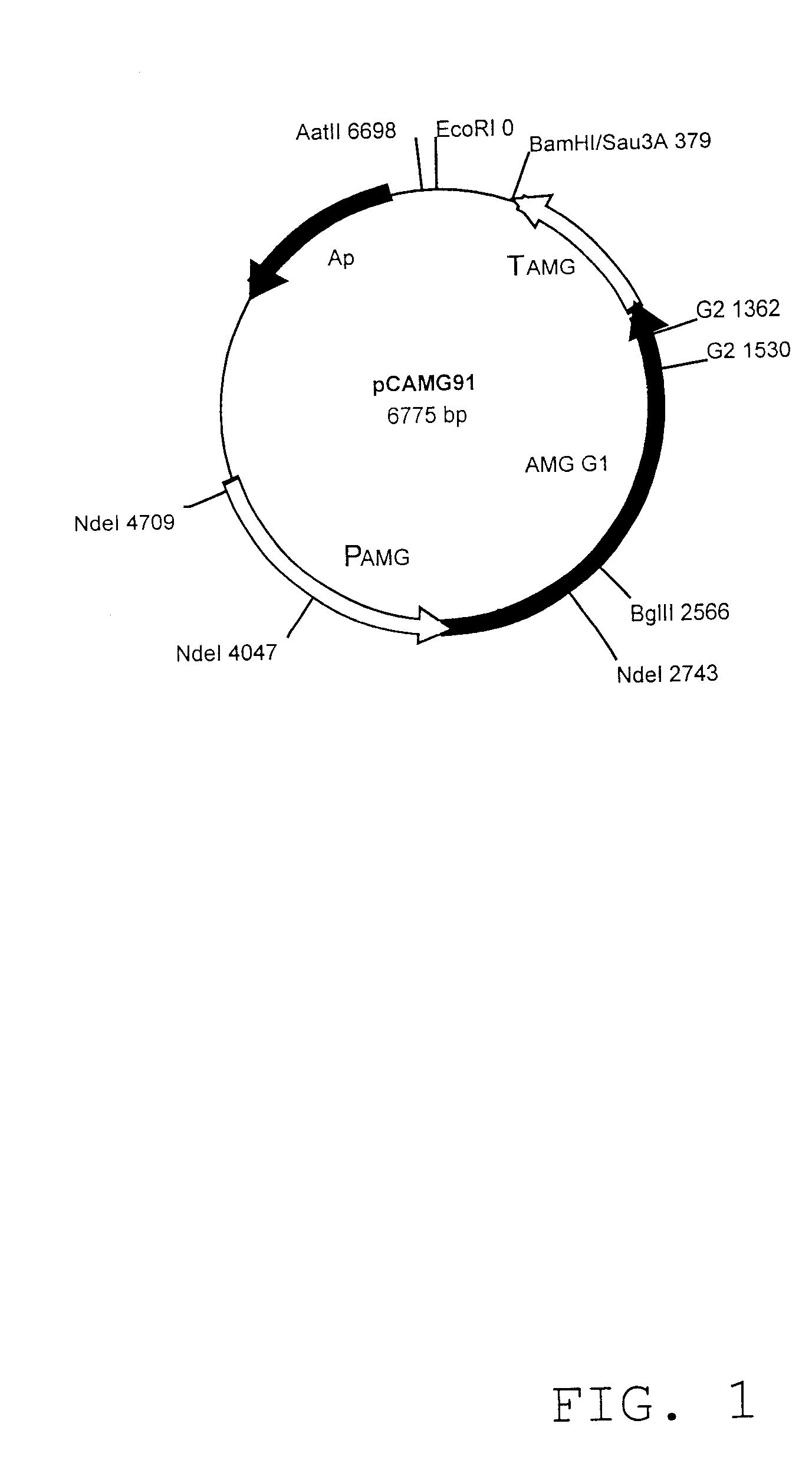Glucoamylase variants
a technology of glucoamylase and variants, applied in the field of glucoamylase variants, can solve the problem of relative low thermal stability of glucoamylase, and achieve the effect of improving thermostablility and increasing specific activity
- Summary
- Abstract
- Description
- Claims
- Application Information
AI Technical Summary
Benefits of technology
Problems solved by technology
Method used
Image
Examples
example 1
Construction of AMG G2 Variants
Site-directed mutagenesis:
For the construction of variants of AMG G2 (SEQ ID NO: 2) the commercial kit, Chameleon double-stranded, site-directed mutagenesis kit was used according to the manufacturer's instructions.
The gene encoding the AMG G2 enzyme in question is located on pMT838 prepared by deleting the DNA between G2 nt. 1362 and G2 nt. 1530 in plasmid pCAMG91 (see FIG. 1) comprising the AMG G1 form.
In accordance with the manufacturer's instructions the ScaI site of the Ampicillin gene of pMT838 was changed to a Mlul site by use of the following primer:
7258: 5'p gaa tga ctt ggt tga cgc gtc acc agt cac 3' (SEQ ID NO: 3).
(Thus changing the ScaI site found in the ampicillin resistance gene and used for cutting to a MluI site). The pMT838 vector comprising the AMG gene in question was then used as a template for DNA polymerase and oligo 7258 (SEQ ID NO: 3) and 21401 (SEQ ID NO: 4).
Primer no. 21401 (SEQ ID NO: 4) was used as the selection primer.
21401:...
example 2
Construction, by Localized Random, Doped Mutagenesis, of A. niger AMG Variants Having Improved Thermostability Compared to the Parent Enzyme
To improve the thermostability of the A. niger AMG random mutagenesis in pre-selected region was performed.
Residue:
Region: L19-G35
Region: A353-V374
The DOPE software (see Materials and Methods) was used to determine spiked codons for each suggested change in the above regions minimizing the amount of stop codons (see table 1). The exact distribution of nucleotides was calculated in the three positions of the codon to give the suggested population of amino acid changes. The doped regions were doped specifically in the indicated positions to have a high chance of getting the desired residues, but still allow other possibilities.
The first column is the amino acid to be mutated, the second column is the percentage of wild type and the third column defined the new amino acid(s).
The resulting doped oligonucleotide strand is shown in table 2 as sense st...
example 3
Construction, by PCR Shuffling Spiked with DNA Oligos, of A. niger AMG Variants Having Improved Thermostability Compared to the Parent Enzyme
The polymerase chain reaction (PCR) method was used to prepare DNA fragments carrying the AMG gene and flanking regions. Approximately 10 ug DNA was digested with Dnase, and run on a 2% agarose gel. Fragments of 50-150 bp were purified from the gel. Approximately 1 ug purified fragments were mixed with a 5-15 fold molar excess of oligos carrying the desired mutations. The oligos were of the following kind (for the construction of Hklib1, Hklib2, Hklib3 etc., respectively):
Hklib1:
Hk1-T2X:
5'-ATGTGATTTCCAAGCGCGCGVNNTTGGATTCATGGTTGAGCAA
Hk1-N9X:
5'-CCTTGGATTCATGGTTGAGCVNNGAAGCGACCGTGGCTCGTAC
Hk1-A11X:
5'-ATTCATGGTTGAGCAACGAAVNNACCGTGGCTCGTACTGCCAT
Hk1-L66X:
5'-TCCTCAAGACCCTCGTCGATVNNTTCCGAAATGGAGATACCAG
Hk1-S386X:
5'-CTTTCGCCGATGGCTTCGTCVNNATTGTGGAAACTCACGCCGC
Hk1-E389X:
5'-ATGGCTTCGTCTCTATTGTGVNNACTCACGCCGCAAGCAACGG
Hk1-T390X:
5'-GCTTCGTCTCTATTGTGGAAVNNCACGCC...
PUM
| Property | Measurement | Unit |
|---|---|---|
| Fraction | aaaaa | aaaaa |
| Temperature | aaaaa | aaaaa |
| Temperature | aaaaa | aaaaa |
Abstract
Description
Claims
Application Information
 Login to View More
Login to View More - R&D
- Intellectual Property
- Life Sciences
- Materials
- Tech Scout
- Unparalleled Data Quality
- Higher Quality Content
- 60% Fewer Hallucinations
Browse by: Latest US Patents, China's latest patents, Technical Efficacy Thesaurus, Application Domain, Technology Topic, Popular Technical Reports.
© 2025 PatSnap. All rights reserved.Legal|Privacy policy|Modern Slavery Act Transparency Statement|Sitemap|About US| Contact US: help@patsnap.com

